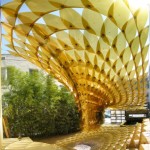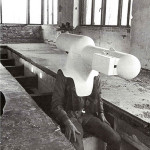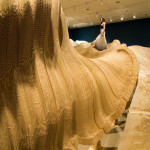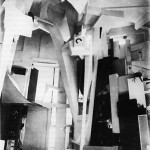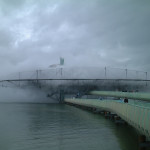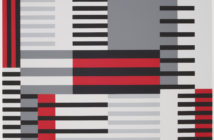We acknowledge that the installation sits squarely within the realm of the arts, emerging as a response to both the specifics of the arts and larger cultural forces. It is our hope that the architectural profession can better understand how to engage the medium by building upon the experience of the arts, using it as a tool to assess and improve the field we love. Because, between you and me, architecture is in a state of crisis.
The current economic climate has devastated the profession: construction revenue has dropped by forty percent, and approximately twenty-eight percent of all architectural positions have been eliminated over the past three years. The profession has become a commodity that few appreciate and even fewer can afford, yet all could receive its benefit. The development of new, high-performance materials and intelligent building systems have changed the architectural pallet for the first time since the introduction of structural steel and plate glass following the Industrial Revolution. The integration of computer software into the design process has lead to the abandonment of the fixed projection plane of the Renaissance, replacing it with the fluidity of 3+ dimensional spatial modeling. New automated fabrication methods developed in the aerospace and manufacturing industries are posed to replace the traditional building techniques that have shaped architecture since ancient times. If there ever were a time that the profession was in need of critical reexamination, it is now. While there is no single answer to the challenges that we face, installation art is ideally situated to provide the profession with a much needed tool to better understand both itself and its relationship to the rapidly changing world around it.
Origins
Despite Frank Lloyd Wright’s claim of architecture as the mother art, architects stand as outsiders to the art world. If we hope to learn from the arts it is important that we base our understanding of installation art not solely on the work that it has produced, but more importantly upon the larger conditions from which it emerged. As Hugh Davies points out in Blurring the Boundaries, Installation Art 1969-1996, this requires that we begin with the images found on the walls of the caves of Lascaux and Altamira, some of the earliest examples of human art. Placed directly on the cave walls2, the very spaces in which the authors of the paintings lived, these pieces are undeniably site specific and tied to the architecture, if only as primitive ornament. Fixed in space and strongly contextual, they were created to be more than passively viewed images, they are part of a shared and uniquely Paleolithic experience3. While these earliest examples of art didn’t directly engage their audience in the same manner that contemporary installation does, they did connect their format directly to active experience, a key trait of installation. Thousands of years later, the experience of these images is still a spatial experience4, dependent upon the movement of the observer through the atmosphere of the cave.
The conceptual space that installation art will eventually inhabit was first explored by Marcel Duchamp’s carefully chosen series of readymades. Beginning with Advance of the Broken Arm (1915) Duchamp elevated the everyday object to the status of art through the curatorial process, intentionally intensifying the problem of objectivity within art5. In doing so the viewer, through the questioning of the work’s relevance and validity, becomes an active participant in the piece, activating the space between the work and the viewer. The value of the piece isn’t derived from the object itself, but rather from its relationship to the viewer and the conceptual questions its provokes. Installation art has been described as operating between sculpture and the readymade, and the themes found within Duchamp’s pieces have become central to the identity of installation art.
Merzbau (1923-1943) by Kurt Schwitters is a seminal work often referenced as the first documented installation piece. Evolving over a twenty year span in Schwitters apartment in Hanover, Germany, the end result was a built environment effectively combining aspects of collage, interior design and sculpture into a unified environment, foreshadowing the work of the 1960’s and 1970’s6.
Schwitters’ architectural-scale assemblage Merzbau is a prototypical example of how an aspect of the arts, in this case a combination of Dadaism and Constructivism, can manifest themselves physically within daily life. In the creation of the piece Schwitters created a site specific environment in which, as Mark Rosenthal notes, the viewer is so directly engaged with the environment of the installation that the outside world becomes unrecognizable, that
"[in this]overall environment with little or no escape route, the enchantment draws heavily on theatrical roots, the suspension of disbelief being chief among these. One witnesses an extreme vision of reality or may have the sense of being inside the artist’s mind; indeed, a simulacrum of a consciousness is created."7
The Emergence of Installation Art
Installation art fully emerged as an independent medium for experimentation during the late 1960’s and early 1970’s. Pioneered by the work of groundbreaking artists who combined the participatory energy of performance art with a desire to challenge the perceived sacredness of surface in the arts, installation quickly became a new art form well-suited to accommodate the demands of their rapidly changing cultural context. As artists began to create holistic environments where object and viewer participated in an active dialog the boundaries between performance art, land art and interactive art dissolved, allowing artists to engage their physical, cultural and social context in a new manner. Suddenly it was possible to similarly use the land, stage or the gallery itself (not just the walls) as a canvas to create physical environments, exploring social norms, taboos and new artistic mediums. Artists were liberated from the constraints of surface and abstraction which had come to dominate the arts; viewers of the work, who until this point had only witnessed art as a third party were challenged with a participatory role8. Artists like Robert Smithson, Carl Andre and Gordon Matta-Clark provided social critique alongside physical space with the intent that their audience contribute to a communal voice that demanded to be heard.
Austrian artist and architect Walter Pichler (1936-2012) began his professional career as an architect in the early 1960’s. Pichler gained international recognition for unbuilt projects presented through drawings borrowing from the conventions of both architecture and the fine arts. In these projects he sought to create "an architecture which fascinates"9, provoking a response from the viewer through his repeated questioning of convention and the boundaries of tradition. Proclaiming that "architecture should be free from the constraints of construction, and sculpture from the limits of abstraction"10, Pichler began testing this notion in built work rather than through the surface condition of drawing. Tragbares Wohnzimmer (Wearable Living Room, 1967) was comprised of a submarine-shaped helmet designed to be worn on the head, an isolated solitary space conversely removed from the inhabitant’s external environment. The apparatus served as an artistic/cybernetic augmentation that simultaneously limited and extended the capabilities of the human body conveying a critique of contemporary media and pop culture.
After being trained as an architect at Cornell University, Gordon Matta-Clark (1943-1978) pursued a career in the art world, combining filmmaking, drawing, writing and modifications to the built environment. Through this amalgamation Matta-Clark questioned the conventions of architecture itself, critiquing the discipline's overwhelming desire to make new buildings during a time when city neighborhoods were falling into decay due the prevailing practice of urban renewal. Reversing the conventions of the time Matta-Clark chose the deconstruction of space over the construction of form, with this inversion forming the basis for his well known series of "building cuts". Splitting (1974) involved the cutting of an existing 1930’s building slated for demolition to make way for a proposed redevelopment11. Matta-Clark’s incision from the roof to the foundation formed a split, allowing daylight to enter and dividing the building in two while calling attention to the social divide over the contentious subject of urban renewal.
The work of Richard Serra stands in strong contrast to the work of Pichler and Matta-Clark. Pichler’s most significant works were created and resided on his remote private farm in eastern Austria and Matta-Clark’s projects occupied condemned buildings inaccessible to the general public - both artists provided little room for the participation of the viewer in the piece. Serra’s work instead relies on a symbiotic relationship between the piece and the viewer, inescapably physical and spatial in nature. To experience the work is to understand it.
In Tilted Arc, his 1981 piece in New York City’s Federal Plaza, Serra described the spatial relationship of viewer to the piece as one that allows the viewer to become
The visceral nature of Tilted Arc proved to be highly controversial from the moment it was installed, resulting in a lengthy public debate. This work was a victim not of what it stood for but where it stood. Early in the proceedings the idea of relocating it was presented to Serra, who argued that the work was so site-specific that moving it would undermine its existence. After the appeal process Tilted Arc was dismantled and removed from Federal Plaza. It was not the meaning of the work nor what it symbolized that lead to its demise, but rather its sheer physical presence in the plaza.
While the work of Pichler, Matta-Clark and Serra varies formally and conceptually, the work of all three relies on some manner of active participation from the viewer and an engagement with the space (physical, social or otherwise) surrounding the work. Through these interdependencies the work is understood and the medium of installation reveals one of its central properties: meaning is conveyed through direct experience. One of installation’s greatest assets is its connection to the temporal dimension of the everyday. Installation is a means to explore and understand the inseparable linkage between art and life. As Mark Rosenthal has proposed,
"...for modern artists, the old forms and concepts of art needed refurbishment, their premise being that the world is far more complex and rich than earlier practice had allowed. The aspiration of the modern installation artist became in large part how to reflect the experience of life - its complex issues, aspects, and appearances. The technique of installation has proved to be a useful tool by which to rhetorically speak about and investigate life."12
The Architectural Installation
| Many of the underlying circumstances that lead to the development of installation art during the 1960’s and 1970’s re-emerged within architecture approximately 10 years later.Confronted by the possibilities inherent in new technologies, evolving social forces and economic conditions, installation became a vehicle for architects to question the modes of thought and representation galvanized by the International movement. Many of these designers had witnessed or participated in the success of installation in the arts, it is no surprise that they quickly took to the medium as a tool to examine how these emerging conditions might manifest themselves in the built environment. Despite the similarities held between initial conditions, the details of the criteria (underlying theoretical implications, the service nature of the architectural profession, etc.) required that their response be specific to the needs of the profession. The architectural application of the installation as a medium that emerged for architecture had different goals from those found in the arts and took on a distinct character. To both acknowledge these differences and facilitate a conversation around them, we have opted to refer to them as architectural installations. |
Like in art, the architectural installation has no shared formal language, as it is required to challenge and explore a wide breadth of architectural topics. Instead of a shared formal language there are two teleological constants that can assist us in identifying and utilizing the architectural installation.
The first constant is that the piece is required to attempt to participate and engage the activity of space-making. At its most primitive level architecture is the act of manipulating space through the built form - for an installation to identify with the this constant it must approach this topic13. By default the medium of installation as a whole is a spatial experience, and all installations can be considered to embody space-making. There is no difference between the condition of space-making within the artistic installation and architectural installation. This reinforces the base concept that the medium of installation remains part of the artistic domain and that all installation work (and their artist) can begin to point towards architectural concepts.
The second constant used to identify the architectural installation is that its point of investigation should have aspirations or implications for the default medium of architecture: buildings. While the architectural installation can still be a means to its own end, it must, at some level, be asking questions whose answers carry weight in the more traditional realms of architecture. This is not to say that the architectural installation is intended to deal only with more concrete aspects of architecture such as tectonics, but rather that the questions it provokes should cause architects at least consider the implications of the architectural installation in their own work.
Praxis, Pedagogy and Discourse
With "place-making" and "building-scale aspirations" as our wayfinders, it is possible to map the areas of the architectural profession where the installation has made inroads. Architecture, like any other intellectual pursuit, is a complicated network of forces that can be challenging to navigate even for those familiar with it. Thankfully it can be conceptually modeled as having three facets: pedagogy, praxis and discourse. Each is constantly changing due to the flux of individuals that engage it: each component can be used to understand and influence the other and there is no established hierarchy between them. To varying extents the architectural installation has utilized by all of them, providing three equally unique perspectives to its inclusion in architecture.
Praxis
Of these three areas, installation has been utilized in the praxial investigations of architecture the longest, leveraging the capabilities of the architectural installation as a methodology explores ideas in the built form. The reality is that the construction industry revolves around clients and contractors, banks and building codes: elements rarely concerned with or prepared to accommodate the systematic interrogation of the polemic presented by the conceptual, social and technological potential of architecture. Just as it did with the arts, the medium of installation’s inherent fluidity coupled with the immediacy of its returns permits in-depth explorations into topics of concern without preconditions or preconceptions. The architectural installation provides the profession with a format sympathetic to the desire to explore these polemics through the built environments.
As a result of the constraints placed on architecture by the reality of the building industry, there have been a number of young14 and ambitions practices using architectural installation to engage these polemics, with the results often re-emerging in their work after they’ve attracted clientele willing to address similar issues15. Some practices may abandon the medium after they’ve moved onto larger commissions, while others choose to employ installations as a research tool alongside more traditional architectural projects.
One architectural practice that used architectural installation at the onset of their career is the office of Diller Scofidio + Renfro (DS+R). An established, avant-garde practice DS+R has a number of high-profile built projects such as The Institute of Contemporary Art, Boston (2006), the High Line in New York City (2009) and Alice Tully Hall at the Juilliard School (2009). Due to the economic constraints of the late 70’s and a desire to control all aspects of their work, installation and performance became the primary means of exploring architectural concepts rather than construction.The methodologies manifest in their built projects have evolved out of earlier interdisciplinary projects bridging art, performance and architecture through the medium of installation. In the 2003 New York Times article preceding the Whitney Museum of American Art’s retrospective of DS+R’s work, writer Arthur Lublow identified some notable works from this period including: Traffic (Columbus Circle, New York City, 1981), in which the architects arranged 2,500 traffic cones for a period of 24 hours to convey traffic patterns, and Para-Site (1989), which introduced the aspect of audience as performance and plays with the difference between seeing and being seen.
Blur Building (2002), a pavilion constructed for the 2002 Swiss National Expo, combined the diverse interests explored in earlier Diller Scofidio + Renfro projects and encapsulated them in a "traditional" architectural project. An elevated platform in Lake Neuchatel in Yverdon-les-Bains, Switzerland, the pavilion engaged the environment and visitors by networking high-pressure micro sprayers with sensor-embedded raincoats. Resulting in an ephemeral blur of mist that responded to the movements of the visitors and climatic conditions, Blur Building synthesized elements of space, environment and spectacle while still providing for the programmatic requirements of the pavilion.
An interesting development within architectural praxis is the field’s acceptance of architectural installation as a singular mode of participation within the profession. A small number of architectural practices are choosing to focus exclusively on explorations through installation rather than more traditional commissions, arguably rejecting the very medium that defines their field. In the past such practices were considered to be operating at the fringe of the profession, but within the past decade those choosing this model of practice have been celebrated by the profession as a whole through awards, publication and speaking engagements. While its is clear that these practices don’t participate in the design and production of architecture, the profession has opted to categorize their work within the boundaries of architecture due to the provocative nature of the questions asked of the profession itself by their work.
The Los Angeles based interdisciplinary practice of Ball-Nogues Studio began their careers at the overlap of architecture, design, and film. From the start they utilized the architectural installation as a means of exploring space making, fabrication methodologies and material investigations. They have positioned their work as "informed by the exploration of craft," and concerned primarily with the design of "the production process itself, with the aim of creating environments that enhance sensation, generate spectacle and invite physical engagement."
Ball-Nogues Studio quickly garnered acclaim after the completion of the temporary installation Maximillians Schell (Los Angeles, CA, 2005). Designed using parametric modeling software and fabricated with CNC technology16, the installation functioned as a shading device while forming a space which fostered social interaction. Rip Curl Canyon (Houston, TX, 2006), following shortly after the Maximillians Schell installation, represented a more intimate exploration of viewer participation, examining "...the potential of constructing landscapes in cardboard to include the viewer’s physical participation," inviting "visitor exploration by extending the casual social terrain of the campus into the gallery, transforming it into a traversable rolling playground." In addition to having placed pieces in the permanent collection of MoMA and LACMA, Ball-Nogues Studio has received multiple awards from the Los Angeles chapter of the American Institute of Architects, and the principals of the practice lecture extensively across the globe.
Pedagogy and Discourse
A long-standing critique of the academic arena where architectural pedagogy unfolds is that the design studio is too dependent upon conceptual projects. That students are often taught to be more adept at exploring the theoretical aspects of architecture completely removed from the real-world design implications of context and construction. In direct response to this commentary, academic design studio across the globe have begun to utilize the immediacy of architectural installation alongside its conceptual ambiguity (often coupled with the design/build17 model of practice) as a means to bridge this divide and participate in both hemispheres of the profession. The development of an installation’s theoretical goals and formal characteristics allow students to explore the full potential of the built form, while participating in its physical construction provides them hands-on experience with the act of making and the specifics of construction.
Discourse has proved to be the most difficult of the three facets for architectural installation to incorporate itself into. As praxis and pedagogy have employed installation as vehicle for auxiliary explorations instead of critical examinations of the medium itself, architectural installation has remained largely off the radar of the institutions (physical or conceptual) that are driving architectural discourse. That is not meant to imply that discourse has been completely blind to the increasing role being played by installation in architecture18. In early 2012 the University of Michigan’s A. Alfred Taubman College of Architecture and Urban Planning hosted the Whither Symposium, a series of conversations revolving around the position that installation has become "the conceptual framework by which the discipline of architecture imagines itself." There was a pointed intent by those participating in the discussion panels to refer to installation as a topic rather than just as a tool19. It would be overly bold to insinuate that this single event is indicative of architectural installation as whole becoming full ingrained in architecture discourse, rather it shows that installation is slowly being incorporated into the heart of the field.
Conclusion
Only recently has the medium of installation gained enough currency that an honest examination of its unique character and potential has begun to enter the architectural milieu. Due to the relative freshness of the topic there is no universal agreement on its long-term viability, and some feel that it is yet to prove itself as more than a trend in a profession overly-susceptible to styles and movements. Much to our chagrin the subject of architectural installation is moving quickly and the resulting dialogue can be considered speculative and inconclusive at best.
Architects and other spatial thinkers have embraced the format of installation partially due to its inclusive nature. The last decade has shown evidence of an energized resurgence in the area of installation from the domain of architecture, with theorists, academics and practitioners turning their focus towards it with increasing regularity. The success of the projects produced during this latest surge of interest have led the field to reevaluate its previously held views on the role of installation, elevating it from a mere fringe exercise to a critical tool.
The appropriation of installation as a critical tool within architecture has lead to the development of a new classification of installation project: the architectural installation. Situated squarely between the realms of arts and architecture, the architectural installation leverages the capabilities of installation to address the specific aesthetic, technological and social challenges of contemporary architecture. The critical lens provided by installation, originally used to challenge the ontology of art, has been turned upon architecture in much the same way, resulting in a much-needed questioning of the discipline’s boundaries and beliefs.
As one would expect, the use of architectural installation as more than a medium for self expression is evident in the examples cited in this text. Returning to the work and trajectory of the strongest example, Diller Scofidio + Renfro, one can see the benefits of the strategic deployment of architectural installation as a means of critical engagement throughout the entirety of the firms work. In discussing the firm’s work Aaron Betsky, director of the Netherlands Architecture Institute and curator of the Whitney retrospective of their work says, ''In experimental architecture and design, they [Diller Scofidio + Renfro] are the only ones who made as the core of their work the question 'What do we mean by architecture?'" It is precisely this line of questioning that expands our collective understanding of the disciplinary boundaries that traditionally exist by thoughtfully invoking architectural installation as a vehicle of reinvention.
[1]Gordon Matta-Clark studied architecture at Columbia University and Walter Pichler practice as an
architect in Austria before focusing on his more artistic pursuits.
[2]Blurring the Boundaries, Installation Art 1969-1996 by Hugh Davies, pg. 8
[3]Blurring the Boundaries, Installation Art 1969-1996 by Hugh Davies, pg. 8
[4] The images that tourist view are facsimiles produced to protect the originals, placed in nearby caves to
closely replicate the location of the originals.
[5]Andrew Benjamin, "Matter and Meaning: On Installations", Art & Design Magazine No. 30.(1993): 31-33
[6]Installations by Architects, Experiments in Building and Design by Sarah Bonnemaison and Ronit
Eisenbach
[7]Understanding Installation Art From Duchamp to Holzer by Mark Rosenthal, p 33
[8] Understanding Installation Art From Duchamp to Holzer by Mark Rosenthal, p 25
[9] "Walter Pichler, an Artist Who Bucked the Status Quo" New York Times, Art & Design 29 July 2012,
A22
[10] Installations by Architects, Experiments in Building and Design by Sarah Bonnemaison and Ronit
Eisenbach, p17
[11] Gloria Moure, Gordon Matta-Clark: Works and Collected Writings (Poligrafa, 2006)
[12]Understanding Installation Art From Duchamp to Holzer by Mark Rosenthal, p 26-27
[13]It is not the charge of this paper to establish what qualifies a successful attempt, but rather expect that
a conscious attempt is made.
[14]"Young", in this context is not a matter of the age of the participants, but rather of the practice itself.
[15]Diller Scofidio + Renfo, Lewis.Tsurumaki.Lewis Architects and SHoP Architects are some that
immediately come to mind.
[16]CNC is an acronym for "Computer Numeric Control", the technology that allows the automated movement of numerous industrial fabrication processes.
[17]Design/build has a number of different meanings within architecture, in this instance, from a pedagogical the term refers to its most simplistic of meanings: one in which the students design a project and construct it themselves to better understand the physical implications of their design decisions.
[18]The simple fact that this paper is being written attest to the increased attention being paid to installations from the various facets of architecture.
[19]Videos of the discussions can be found at http://vimeo.com/taubmancollege.
- DS+R, Para-Site, 1989.
- Ball-Nogues Studio, Maximillian’s Schell, 2005. Photograph by Neil Cochran.
- Walter Pichler, Tragbares Wohnzimmer, 1967.
- Ball-Nogues Studio, Rip Curl Canyon, 2006. Photograph by Nash Baker
- Kurt Schwitters, Merzbau, 1923-1943.
- DS+R, Blur Building, 2002.







